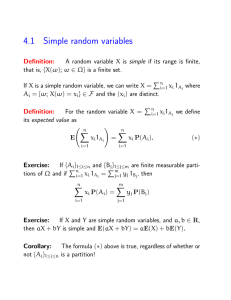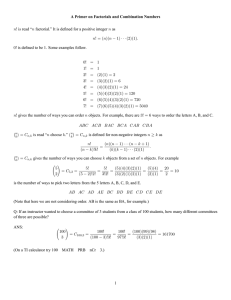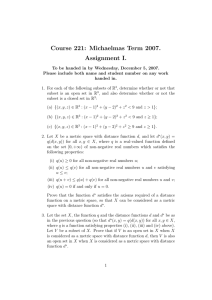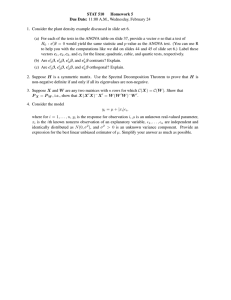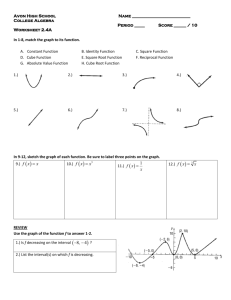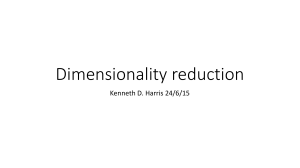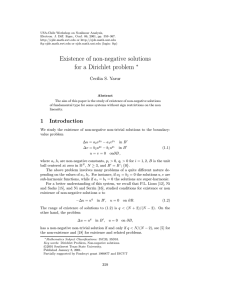MA1S11 Calculus, Tutorial Sheet 2 13-16 October 2015
advertisement
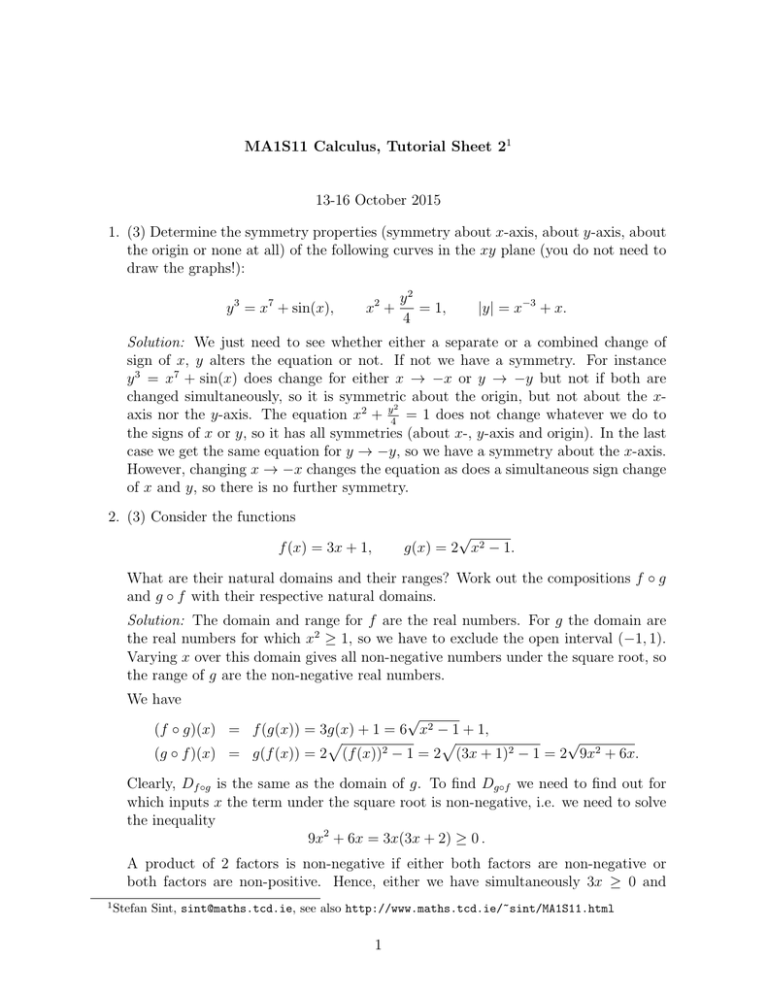
MA1S11 Calculus, Tutorial Sheet 21
13-16 October 2015
1. (3) Determine the symmetry properties (symmetry about x-axis, about y-axis, about
the origin or none at all) of the following curves in the xy plane (you do not need to
draw the graphs!):
y 3 = x7 + sin(x),
x2 +
y2
= 1,
4
|y| = x−3 + x.
Solution: We just need to see whether either a separate or a combined change of
sign of x, y alters the equation or not. If not we have a symmetry. For instance
y 3 = x7 + sin(x) does change for either x → −x or y → −y but not if both are
changed simultaneously, so it is symmetric about the origin, but not about the x2
axis nor the y-axis. The equation x2 + y4 = 1 does not change whatever we do to
the signs of x or y, so it has all symmetries (about x-, y-axis and origin). In the last
case we get the same equation for y → −y, so we have a symmetry about the x-axis.
However, changing x → −x changes the equation as does a simultaneous sign change
of x and y, so there is no further symmetry.
2. (3) Consider the functions
√
g(x) = 2 x2 − 1.
f (x) = 3x + 1,
What are their natural domains and their ranges? Work out the compositions f ◦ g
and g ◦ f with their respective natural domains.
Solution: The domain and range for f are the real numbers. For g the domain are
the real numbers for which x2 ≥ 1, so we have to exclude the open interval (−1, 1).
Varying x over this domain gives all non-negative numbers under the square root, so
the range of g are the non-negative real numbers.
We have
√
(f ◦ g)(x) = f (g(x)) = 3g(x) + 1 = 6 x2 − 1 + 1,
p
p
√
(g ◦ f )(x) = g(f (x)) = 2 (f (x))2 − 1 = 2 (3x + 1)2 − 1 = 2 9x2 + 6x.
Clearly, Df ◦g is the same as the domain of g. To find Dg◦f we need to find out for
which inputs x the term under the square root is non-negative, i.e. we need to solve
the inequality
9x2 + 6x = 3x(3x + 2) ≥ 0 .
A product of 2 factors is non-negative if either both factors are non-negative or
both factors are non-positive. Hence, either we have simultaneously 3x ≥ 0 and
1
Stefan Sint, sint@maths.tcd.ie, see also http://www.maths.tcd.ie/~sint/MA1S11.html
1
3x + 2 ≥ 0 or we have simultaneously 3x ≤ 0 and 3x + 2 ≤ 0. In the first case x ≥ 0
is the stronger condition and in the second case x ≤ −2/3 is the stronger condition.
Therefore
Dg◦f = {x : x ≤ −2/3 or x ≥ 0}.
√
3. (2) We define the function f (x) = x3 − 1. What is its natural domain and its
range? Is this function invertible? If so, determine the inverse function with its
domain and range.
Solution: The function is real if the expression under the root is non-negative, i.e. if
x3 − 1 ≥ 0 This simplifies to x ≥ 1, so the natural domain are the real numbers ≥ 1.
Varying x over the domain one gets all non-negative real numbers, which defines the
range of f . The function is strictly monotonically increasing and thus invertible. A
graph of the function is given in figure 1 Solving y = f (x) for x,
10
8
6
4
2
K4
K2
0
2
x
Figure 1: question 1: graph of f (x) =
y=
√
4
√
x3 − 1 ⇔ y 2 + 1 = x3 ⇔ x =
and exchanging x and y we have
f −1 (x) =
√
3
x3 − 1.
p
3
y2 + 1
x2 + 1 = (x2 + 1)1/3
The domain of the inverse function f −1 is the range of f , so all real numbers x ≥ 0,
and the range of f −1 coincides with the domain of f , so all numbers y ≥ 1.
2
5
4
3
y
2
1
0
0
1
2
3
x
Figure 2: question 1: graphs of f (x) =
√
4
5
x3 − 1 and its inverse f −1 (x) = (x2 + 1)1/3 .
3

